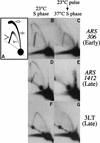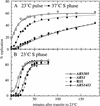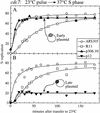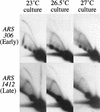Cdc7 is required throughout the yeast S phase to activate replication origins
- PMID: 9472018
- PMCID: PMC316537
- DOI: 10.1101/gad.12.4.491
Cdc7 is required throughout the yeast S phase to activate replication origins
Abstract
The long-standing conclusion that the Cdc7 kinase of Saccharomyces cerevisiae is required only to trigger S phase has been challenged by recent data that suggests it acts directly on individual replication origins. We tested the possibility that early- and late-activated origins have different requirements for Cdc7 activity. Cells carrying a cdc7(ts) allele were first arrested in G1 at the cdc7 block by incubation at 37 degrees C, and then were allowed to enter S phase by brief incubation at 23 degrees C. During the S phase, after return to 37 degrees C, early-firing replication origins were activated, but late origins failed to fire. Similarly, a plasmid with a late-activated origin was defective in replication. As a consequence of the origin activation defect, duplication of chromosomal sequences that are normally replicated from late origins was greatly delayed. Early-replicating regions of the genome duplicated at approximately their normal time. The requirements of early and late origins for Cdc7 appear to be temporally rather than quantitatively different, as reducing overall levels of Cdc7 by growth at semi-permissive temperature reduced activation at early and late origins approximately equally. Our results show that Cdc7 activates early and late origins separately, with late origins requiring the activity later in S phase to permit replication initiation.
Figures






Similar articles
-
The Cdc7 protein kinase is required for origin firing during S phase.Genes Dev. 1998 Feb 15;12(4):480-90. doi: 10.1101/gad.12.4.480. Genes Dev. 1998. PMID: 9472017 Free PMC article.
-
Association of RPA with chromosomal replication origins requires an Mcm protein, and is regulated by Rad53, and cyclin- and Dbf4-dependent kinases.EMBO J. 1998 Sep 1;17(17):5182-91. doi: 10.1093/emboj/17.17.5182. EMBO J. 1998. PMID: 9724654 Free PMC article.
-
Damage-induced phosphorylation of Sld3 is important to block late origin firing.Nature. 2010 Sep 23;467(7314):479-83. doi: 10.1038/nature09377. Nature. 2010. PMID: 20865002 Free PMC article.
-
Functions of mammalian Cdc7 kinase in initiation/monitoring of DNA replication and development.Mutat Res. 2003 Nov 27;532(1-2):29-40. doi: 10.1016/j.mrfmmm.2003.08.008. Mutat Res. 2003. PMID: 14643427 Review.
-
Cdc7 kinase complex: a key regulator in the initiation of DNA replication.J Cell Physiol. 2002 Mar;190(3):287-96. doi: 10.1002/jcp.10070. J Cell Physiol. 2002. PMID: 11857444 Review.
Cited by
-
Replication in hydroxyurea: it's a matter of time.Mol Cell Biol. 2007 Sep;27(18):6396-406. doi: 10.1128/MCB.00719-07. Epub 2007 Jul 16. Mol Cell Biol. 2007. PMID: 17636020 Free PMC article.
-
Crystallization and preliminary X-ray diffraction analysis of motif N from Saccharomyces cerevisiae Dbf4.Acta Crystallogr Sect F Struct Biol Cryst Commun. 2009 Sep 1;65(Pt 9):890-4. doi: 10.1107/S1744309109029376. Epub 2009 Aug 22. Acta Crystallogr Sect F Struct Biol Cryst Commun. 2009. PMID: 19724125 Free PMC article.
-
An N-terminal domain of Dbf4p mediates interaction with both origin recognition complex (ORC) and Rad53p and can deregulate late origin firing.Proc Natl Acad Sci U S A. 2002 Dec 10;99(25):16087-92. doi: 10.1073/pnas.252093999. Epub 2002 Nov 19. Proc Natl Acad Sci U S A. 2002. PMID: 12441400 Free PMC article.
-
The positioning and dynamics of origins of replication in the budding yeast nucleus.J Cell Biol. 2001 Jan 22;152(2):385-400. doi: 10.1083/jcb.152.2.385. J Cell Biol. 2001. PMID: 11266454 Free PMC article.
-
Incorporation into the prereplicative complex activates the Mcm2-7 helicase for Cdc7-Dbf4 phosphorylation.Genes Dev. 2009 Mar 1;23(5):643-54. doi: 10.1101/gad.1759609. Genes Dev. 2009. PMID: 19270162 Free PMC article.
References
-
- Bahman M, Buck V, White A, Rosamond J. Characterisation of the CDC7 gene product of Saccharomyces cerevisiae as a protein kinase needed for the initiation of mitotic DNA synthesis. Biochim Biophys Acta. 1988;951:335–343. - PubMed
-
- Brewer BJ, Fangman WL. The localization of replication origins on ARS plasmids in S. cerevisiae. Cell. 1987;51:463–471. - PubMed
-
- ————— Mapping replication origins in yeast chromosomes. BioEssays. 1991;13:317–322. - PubMed
Publication types
MeSH terms
Substances
Grants and funding
LinkOut - more resources
Full Text Sources
Other Literature Sources
Molecular Biology Databases
Research Materials
